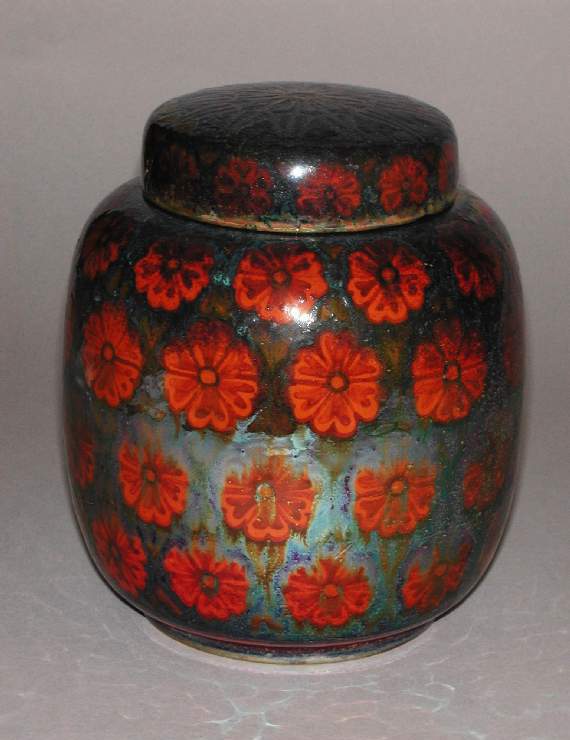Current Location: In storage
Titles
Lustre jar & cover
Maker(s)
Factory:
Pilkington’s Tile and Pottery Company
Designer and decorator:
Mycock, William, S.
Entities
Categories
Description
Earthenware jar and cover with lustre decoration
Barrel-shaped jar on a small foot-rim, with short neck and a fitted, slightly convex, cover. Thrown, white earthenware, the exterior completely covered with a dark blue lustre ground, tinged with copper-gold. The barrel body is decorated with four rows of copper, six-petalled rosette flowers. There is a further row of these around the sides of the cover, the top of which has a central, outline, design of a larger rosette, in a silver-copper coloured lustre. The inside of the lid is painted in blue lustre. The underside is flat and covered with copper-gold lustre.
Notes
History note: From the Charles and Lavinia Handley-Read Collection
Legal notes
Bought with assistance from the Perceval Fund and the V&A Grant in Aid Fund
Measurements and weight
Diameter: 14.4 cm
Diameter: 5.625 cm
Height: 16.5 cm
Height: 6.5 in
Acquisition and important dates
Method of acquisition: Bought
by
Stainton, Thomas
Dating
20th Century, Early
Production date:
circa
AD 1916
Note
Pilkington’s Tile and Pottery Company, formed in 1891/92, was one of the largest producers of decorative tiles. Lancastrian Pottery was introduced in 1904, using simple classical shapes and decorated with innovative coloured glaze effects. Designs were traced and pounced onto the pots, and the decorator was encouraged to add his individuality to that of the designer, such that no two pieces were identical. Painted lustre pottery was produced in quantity from 1906 until 1928. Pilkington’s gained a Royal Warrant in 1913, but tile manufacture dominated production after the First World War, and pottery production ceased in 1938.
The number 3151 denotes the shape. Pilkington’s introduced numbers, starting with 2001, in 1905. Numbers up to 3258 have been recorded (see Cross).
William Salter Mycock (b.1872), worked for Wedgwood and as a jobbing artist before joining Pilkington’s from 1894 until 1938, originally as a tile decorator, and in the pottery from c.1906. His own designs favoured heraldry, flora, birds and ships and sometimes included gothic lettering; he also decorated work with designs by other artists, including Walter Crane. Mycock was also a water-colour painter, interested in music and literature, and a follower of Ruskin. An archive of his design sketches and source material is held by Swinton and Pendlebury Public Library.
School or Style
Art Pottery
Components of the work
Decoration
composed of
lustre
Materials used in production
White earthenware
Techniques used in production
Throwing
: Thrown earthenware, in two parts, glazed and painted with lustre
Painting
Lustring
Glazing
Inscription or legends present
- Text: WSM monogram, enclosed in a wreath
- Location: Underside of base
- Method of creation: Painted in gold lustre
- Type: Mark
- Text: 3151
- Location: Underside of base
- Method of creation: Impressed and painted in gold lustre
- Type: Mark
Inscription present: rosette mark with words below
- Text: ROYAL /LANCASTRIAN / ENGLAND
- Location: Underside of base
- Method of creation: Impressed, under glaze
- Type: Mark
- Text: part of factory logo surrounded by ‘LANCASTRIAN’
- Location: Underside of base
- Method of creation: Circular paper label, red, printed in gold (fragment)
- Type: Label
References and bibliographic entries
Identification numbers
Accession number: C.48 & A-1972
Primary reference Number: 75239
Stable URI
Audit data
Created: Saturday 6 August 2011
Updated: Tuesday 30 April 2024
Last processed: Wednesday 14 May 2025
Associated departments & institutions
Owner or interested party:
The Fitzwilliam Museum
Associated department:
Applied Arts





